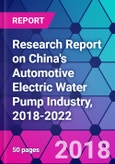As the core part of the engine cooling system, automobile water pumps can be classified into mechanical water pumps and electric water pumps by drive mode. Electric water pumps have advantages such as compact structure, convenient installation, flexible control, reliable performance, low power consumption and high efficiency. They will gradually replace traditional mechanical water pumps in the transformation and upgrading of the automobile industry.
As new energy vehicles develop rapidly in China, there is a surging demand for new-type parts such as automotive electric water pumps. An increasing number of enterprises are accelerating research and development of and setting up production lines for electric water pumps. At present, the Chinese market is monopolized by several dominant enterprises and the competition in the electric water pump industry is fierce because of the high technological and capital barriers and the need for long-term cooperation with downstream automakers. In 2017, the rise in upstream raw material prices pushed up the costs of electric water pumps, and the profit decline of downstream automobile industry crimped the profits of electric water pumps. To win the competition, manufacturers need to keep improving technologies and reducing costs.
The dramatic rise in the production volume of new energy vehicles has opened a broad market for automotive electric water pumps. A traditional fuel vehicle needs only one mechanical water pump while a new energy vehicle needs two to five electric water pumps (about three on average) when using water cooling for precise temperature control over the electric drive, battery and electronic control system. Meanwhile, the unit price of electric water pumps is CNY 300 (60W power) compared with CNY 120 - CNY 150 of traditional ones.
China’s production volume of new energy vehicles ranked the first in the world for three consecutive years from 2015 to 2017, and the sales volume exceeded 770,000 in 2017, which fueled the market demand for electric water pumps. The market size of electric water pumps for new energy vehicles will exceed CNY 3 billion on assumption that each new energy vehicle needs three electric water pumps. On the other hand, as Chinese residents' income increases with fast economic development, the steady growth in high-income households' luxury car consumption increases the market penetration rate of turbocharged engines and further expands the market for electric water pumps. It is expected that in 2022, the proportions of turbocharged passenger vehicles and turbocharged commercial vehicles will reach 40% and 90% respectively in China, the overall penetration rate of electric water pumps will exceed 20%, and the market size of electric water pumps will exceed CNY 5 billion. Electric water pumps are expected to maintain a fast growth rate in China from 2018 to 2022.
Topics Covered:
- Development environment of China's automotive electric water pump industry
- Supply and demand in China's automotive electric water pump industry
- Competition in China's automotive electric water pump industry
- Major automotive electric water pump manufacturers in China
- Factors influencing development of China's automotive electric water pump industry
- Prospect of China's automotive electric water pump industry from 2018 to 2022
Table of Contents
Samples

LOADING...
Companies Mentioned
- Henan Province Xixia Automobile Water Pump Co., Ltd.
- Zhejiang Sanhua Intelligent Controls Co., Ltd.
- Hunan Oil Pump Co., Ltd.
- BorgWarner
Methodology
Background research defines the range of products and industries, which proposes the key points of the research. Proper classification will help clients understand the industry and products in the report.
Secondhand material research is a necessary way to push the project into fast progress. The analyst always chooses the data source carefully. Most secondhand data they quote is sourced from an authority in a specific industry or public data source from governments, industrial associations, etc. For some new or niche fields, they also "double-check" data sources and logics before they show them to clients.
Primary research is the key to solve questions, which largely influence the research outputs. The analyst may use methods like mathematics, logical reasoning, scenario thinking, to confirm key data and make the data credible.
The data model is an important analysis method. Calculating through data models with different factors weights can guarantee the outputs objective.
The analyst optimizes the following methods and steps in executing research projects and also forms many special information gathering and processing methods.
1. Analyze the life cycle of the industry to understand the development phase and space.
2. Grasp the key indexes evaluating the market to position clients in the market and formulate development plans
3. Economic, political, social and cultural factors
4. Competitors like a mirror that reflects the overall market and also market differences.
5. Inside and outside the industry, upstream and downstream of the industry chain, show inner competitions
6. Proper estimation of the future is good guidance for strategic planning.

LOADING...








